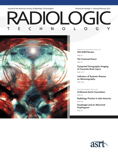
Radiologic Technology
Scope & Guideline
Advancing Knowledge in Radiology and Beyond
Introduction
Aims and Scopes
- Clinical Imaging Techniques:
The journal publishes research on various imaging modalities, including CT, MRI, ultrasound, and radiography, emphasizing advancements in technology, techniques, and protocols that enhance diagnostic accuracy and patient outcomes. - Radiologic Education and Training:
A significant focus is on educational methodologies within radiologic science programs, including curriculum development, student engagement strategies, and assessment methods to ensure high-quality training for future professionals. - Patient Safety and Quality Assurance:
The journal addresses issues related to patient safety in imaging practices, including radiation safety, quality control measures, and the implementation of best practices to minimize risks associated with imaging procedures. - Interdisciplinary Collaboration:
Research on the collaborative efforts between radiologic technologists and other healthcare professionals is a key area, highlighting the importance of teamwork in improving patient care and clinical outcomes. - Emerging Technologies and Innovations:
The journal explores new technologies in medical imaging, including artificial intelligence, advanced imaging techniques, and innovative applications in various clinical settings. - Health Policy and Ethics in Radiology:
Discussion on the ethical implications of radiologic practices, healthcare policies affecting radiologic technology, and the role of radiologic professionals in advocating for patient rights and safety.
Trending and Emerging
- Integration of Artificial Intelligence:
There is a growing interest in the integration of artificial intelligence within radiologic practices, focusing on its potential to enhance diagnostic accuracy, streamline workflows, and improve patient outcomes. - Telemedicine and Remote Imaging:
Research exploring the role of telemedicine in radiology has surged, particularly in light of the COVID-19 pandemic, highlighting the importance of remote consultations and imaging services. - Mental Health and Well-Being in Radiology:
Emerging studies focus on the mental health and well-being of radiologic professionals, addressing issues such as burnout, compassion fatigue, and strategies for creating supportive work environments. - Patient-Centered Imaging Practices:
There is an increasing emphasis on patient-centered care in imaging, with research exploring ways to enhance patient experiences, comfort, and engagement during imaging procedures. - Innovative Educational Strategies:
The journal is seeing a trend towards innovative educational strategies, including simulation-based learning, reflective practices, and the use of technology in teaching radiologic sciences.
Declining or Waning
- Traditional Radiation Safety Practices:
There appears to be a reduced emphasis on traditional radiation safety practices, likely due to the incorporation of new technologies and protocols that inherently improve safety and reduce exposure. - Historical Imaging Techniques:
Research focusing on historical or outdated imaging techniques has decreased, as the field prioritizes contemporary advancements and evidence-based practices over legacy methods. - Single-Modality Research:
There is a noticeable decline in studies focused solely on single imaging modalities, as interdisciplinary approaches and multimodal imaging research gain prominence. - Generalized Patient Care Practices:
The focus on generalized patient care practices has diminished, with more emphasis placed on specialized and nuanced approaches tailored to specific patient populations or conditions. - Basic Imaging Physics Education:
The emphasis on basic imaging physics in educational research has waned, possibly due to a shift towards practical applications and hands-on learning experiences in radiologic programs.
Similar Journals
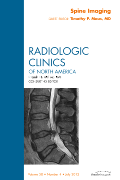
RADIOLOGIC CLINICS OF NORTH AMERICA
Elevating Standards in Radiologic Practice and Education.Radiologic Clinics of North America, published by W B Saunders Co-Elsevier Inc, stands as a pivotal resource in the field of medical imaging and radiology. With a solid history dating back to 1963 and converging years extending to 2024, this journal has established itself as a reputable platform for original research, comprehensive reviews, and insightful discussions that advance the knowledge and practice of radiology, nuclear medicine, and imaging. Holding a Q2 classification in both the miscellaneous medicine and radiology categories and positioned within the 56th percentile among its peers, its contributions are vital for both academic research and clinical applications. Although it does not offer open access, the journal remains accessible through institutional subscriptions and is a must-read for researchers, healthcare professionals, and students keen on the latest developments in radiological practices. With a dedicated editorial board and a commitment to the highest academic standards, Radiologic Clinics of North America continues to shape the future of the medical imaging field.

Tomography
Advancing medical imaging through innovative research.Tomography is an esteemed peer-reviewed journal published by MDPI, focusing on a broad spectrum of topics related to medical imaging and diagnostics. Launched in 2015, this Open Access journal serves as a vital platform for researchers, professionals, and students in the fields of medicine, radiology, nuclear medicine, and imaging. With an impressive impact factor reflecting its relevance, the journal has achieved a quartile ranking of Q2 in both Medicine (Miscellaneous) and Radiology, Nuclear Medicine, and Imaging as of 2023. Renowned for disseminating high-quality research, Tomography welcomes original research articles, reviews, and technical notes, fostering innovation and collaboration within the scientific community. Housed in Basel, Switzerland, the journal aims to bridge the gap between fundamental research and clinical application, appealing to a diverse readership eager to advance the field of medical imaging.
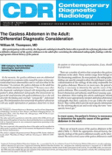
Contemporary Diagnostic Radiology
Advancing the Frontiers of Medical ImagingContemporary Diagnostic Radiology is a pivotal journal in the field of medical imaging and radiology, published by Lippincott Williams & Wilkins. With an ISSN of 0149-9009 and an E-ISSN of 1938-1395, this journal serves as an essential platform for disseminating high-quality research and advances in diagnostic radiology and related disciplines. While it is categorized in the lower quartiles (Q4) for its performance in the 2023 rankings in both Neurology, Radiology, Nuclear Medicine and Imaging, and Surgery, its focus on emerging technologies and methodologies in imaging continues to provide valuable insights for practitioners and researchers alike. The journal’s scope includes innovative diagnostic tools, imaging techniques, and case studies, fostering collaboration and knowledge sharing in the medical community. Although it does not offer open access options, its commitment to contributing to the ongoing dialogue in clinical imaging is undisputed, making it an essential resource for professionals seeking to stay abreast of current trends and research in the rapidly evolving landscape of diagnostic radiology.
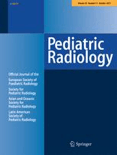
PEDIATRIC RADIOLOGY
Advancing pediatric imaging for better health outcomes.Pediatric Radiology is a leading journal published by Springer that provides a crucial platform for the dissemination of research in the fields of pediatrics, perinatology, and radiology. Since its inception in 1973, the journal has continually contributed to the advancement of medical imaging techniques and their application in diagnosing and treating pediatric conditions. With its impact factor reflecting a Q2 ranking in both Pediatrics and Radiology categories as of 2023, Pediatric Radiology is highly regarded in scholarly circles, aiding researchers, clinicians, and students to stay at the forefront of innovations and findings in the field. Although the journal does not offer open access, it continues to be an essential resource for evidence-based information that enhances clinical practice and improves health outcomes for children globally. The journal's reach is further established through its solid Scopus rankings, indicating its relevance and influence in the global medical community.

Iranian Journal of Radiology
Pioneering Knowledge in the Evolving Field of RadiologyWelcome to the Iranian Journal of Radiology, a pivotal platform dedicated to advancing the field of radiology, nuclear medicine, and medical imaging. Published by BRIEFLAND, this journal aims to disseminate high-quality original research, reviews, and clinical studies that contribute substantially to the global scientific community. Established in 2008 and spanning until 2024, the journal provides an essential archive of knowledge in a rapidly evolving discipline. Although it currently holds a Q4 quartile ranking in the 2023 Scopus metrics, it serves as an important resource for both emerging and established researchers looking to submit their work. Located in the Netherlands, the journal is committed to open dialogue and collaboration amongst professionals in the field, reflecting its accessibility and relevance to both practitioners and academics. With its continued growth and commitment to quality, the Iranian Journal of Radiology is poised to enhance understanding and innovation in diagnostic imaging.

Imaging
Connecting Researchers Through Open Access InsightsImaging, published by AKADEMIAI KIADO ZRT, is an esteemed open-access journal dedicated to the field of medical imaging, established in 2020. With an E-ISSN of 2732-0960 and based in Budapest, Hungary, this journal provides a vital platform for the dissemination of cutting-edge research and advancements in imaging techniques, especially in the realms of radiology, nuclear medicine, and ultrasound technology. While currently positioned in the Q4 category across multiple medical specialties, the journal continues to strive for improvements in visibility and impact, contributing to the evolving discourse in medical imaging. The journal aims to facilitate an inclusive and collaborative environment for researchers, professionals, and students, inviting them to share their findings and insights to enhance the field's development. With open-access availability since its inception, Imaging ensures free and easy access to its content, fostering a greater understanding and appreciation of innovative imaging practices worldwide.
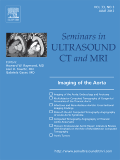
SEMINARS IN ULTRASOUND CT AND MRI
Advancing the Frontiers of Diagnostic ImagingSEMINARS IN ULTRASOUND CT AND MRI is a prestigious academic journal dedicated to advancing the fields of radiology, nuclear medicine, and imaging. Published by W B SAUNDERS CO-ELSEVIER INC, this journal has been a cornerstone of scholarly communication since 1984, providing a platform for high-quality research and review articles that enhance the understanding of diagnostic imaging techniques. With a current impact factor reflected in its Q3 quartile ranking among 333 journals in its category, it remains a valuable resource for researchers and clinicians alike. The journal's focus includes but is not limited to innovations in ultrasound, computed tomography, and magnetic resonance imaging, making it essential for professionals looking to stay at the forefront of imaging science. While it operates under a subscription model, its extensive archive of influential articles ensures ongoing access to critical knowledge and developments in the field. With a commitment to quality and relevance, SEMINARS IN ULTRASOUND CT AND MRI continues to contribute significantly to the evolving landscape of medical imaging.

Imagen Diagnostica
Fostering Excellence in Diagnostic Imaging PracticesImagen Diagnostica is a pivotal journal in the field of radiology and diagnostic imaging, published by the ASOC CATALANA TECNICOS ESPECIALISTAS & DIAGNOSTICO IMAGEN-ACTEDI. With its ISSN 2171-3669 and E-ISSN 2171-9705, it serves as a vital resource for researchers, practitioners, and students engaged in the advancement of imaging technologies and techniques for medical applications. Although the journal coverage in Scopus was discontinued in 2017, the content produced during its active years remains relevant for understanding the evolving landscape of radiology. The journal’s rankings reflect its niche status, ranking #266 out of 276 in the Medicine category and #46 out of 47 in Health Professions, indicating a specific focus within its discipline. Readers can explore insightful articles that contribute to the knowledge base of diagnostic imaging, enhancing their understanding and expertise in this specialized field. Despite its discontinuation, Imagen Diagnostica continues to be a notable reference point for professionals dedicated to furthering diagnostic imaging practices.

Radiologia Medica
Elevating Medical Imaging Research Since 1947.Radiologia Medica, published by Springer-Verlag Italia SRL, is a premier Italian journal dedicated to the field of radiology, nuclear medicine, and imaging. With a rich history dating back to 1947, this journal has consistently provided cutting-edge research and findings, contributing significantly to advancements in medical imaging techniques and practices. As evidenced by its impressive Q1 rankings in both Medicine (Miscellaneous) and Radiology, Nuclear Medicine and Imaging, Radiologia Medica holds a prestigious position within the top tier of medical journals, ranked #11 out of 333 in its category and residing in the 96th percentile according to Scopus metrics. Although it is not currently offered as an Open Access journal, its robust subscription model supports extensive research dissemination. Researchers, professionals, and students alike will find invaluable insights and knowledge critical for advancing their understanding and practice within this dynamic field. Situated in Milan, Italy, Radiologia Medica continues to be an influential platform for the exchange of high-quality research, bridging various disciplines and promoting excellence in radiological science.

SEMINARS IN ROENTGENOLOGY
Pioneering Insights in Radiology and Nuclear MedicineSEMINARS IN ROENTGENOLOGY is a revered journal dedicated to the dynamic fields of Radiology, Nuclear Medicine, and Imaging, published by W B SAUNDERS CO-ELSEVIER INC. With a legacy spanning from 1966 to 2024, this journal provides a platform for comprehensive review articles that foster scholarly discussion and advancement in diagnostic imaging techniques and methodologies. Although currently not an open access publication, SEMINARS IN ROENTGENOLOGY holds significant relevance within its field, reflected by its inclusion in the Q4 category in the latest 2023 Journal Rankings and its position in the 20th percentile among its peers. This journal appeals widely to researchers, professionals, and students aiming to enhance their knowledge and contribute to the evolving landscape of radiologic science. Notable for its informative content and expert insights, SEMINARS IN ROENTGENOLOGY continues to serve as an essential resource for those committed to advancing clinical practice and research in radiology.